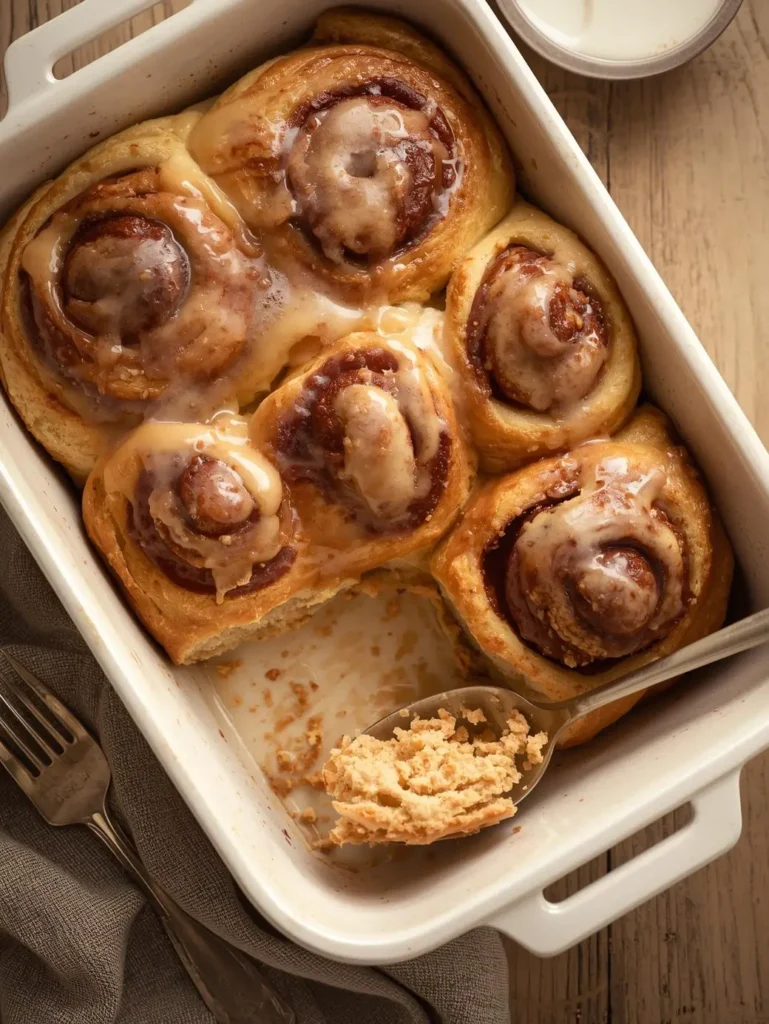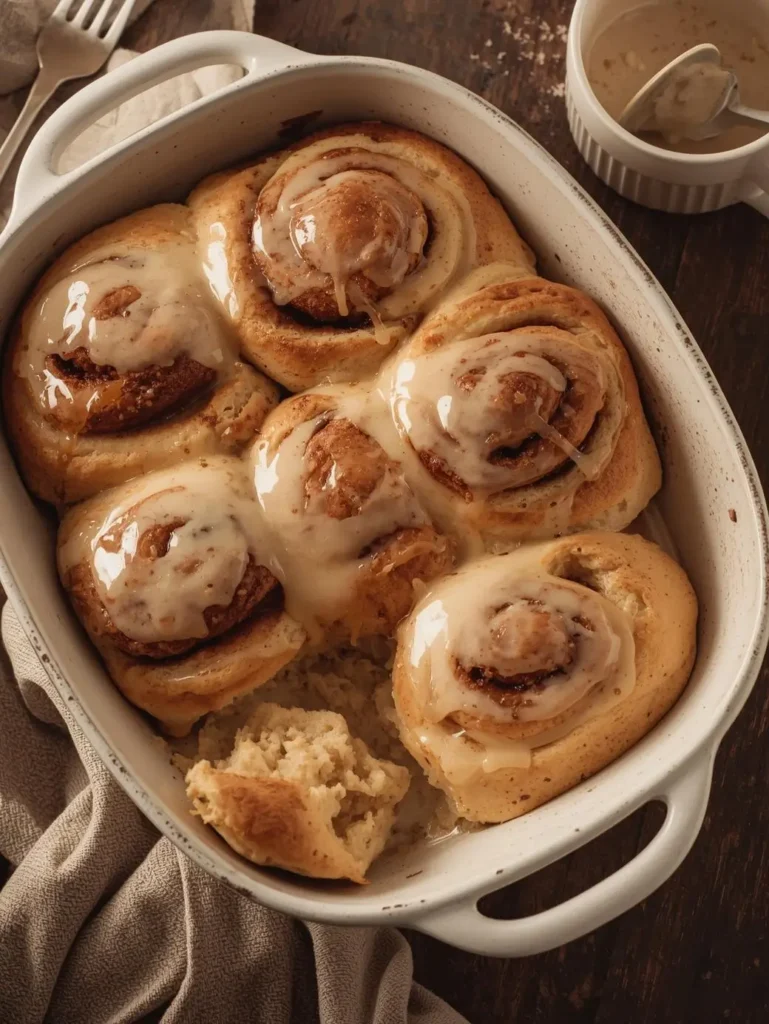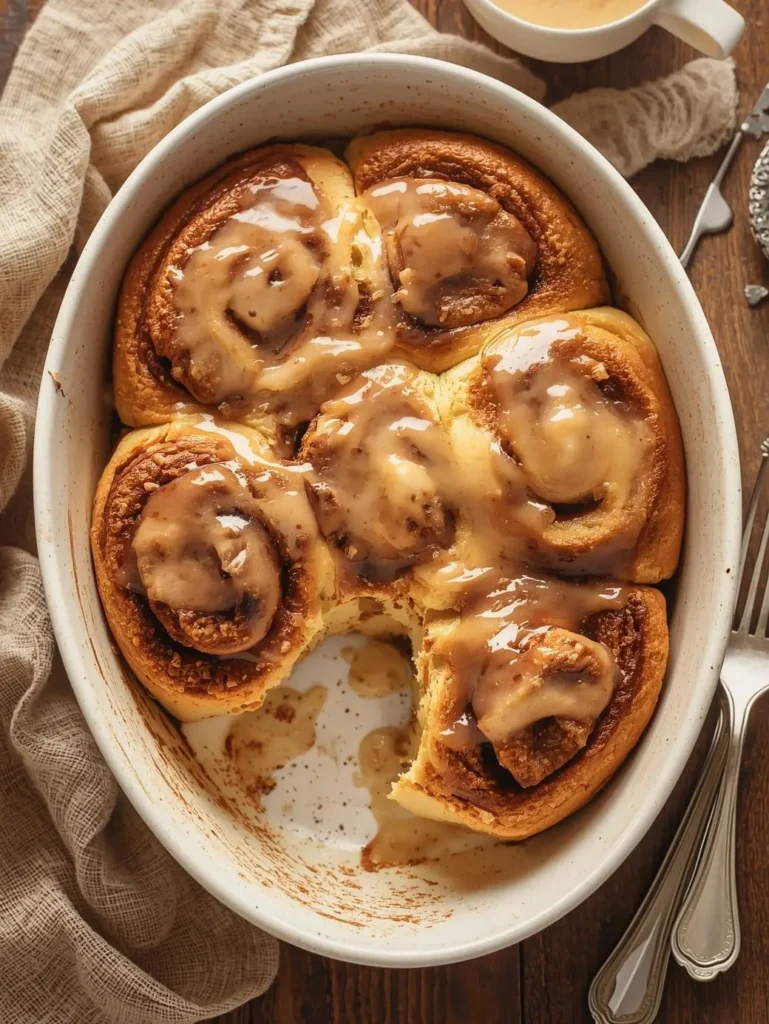Did you know home bakers report softer, fresher rolls when baking at home compared to store-bought, and you can get there faster than you think? A homemade cinnamon rolls recipe can reach the table in about an hour and a half with airy crumb, gooey spirals, and tangy frosting. The secret is a warm, enriched dough and smart proofing.
Introduction
How many times have you been told that good cinnamon rolls require an all-morning marathon? That idea lingers, yet side-by-side tests show enriched doughs can proof in 45 to 60 minutes when the room sits near 75 F, and the flavor holds steady thanks to butter and sugar slowing staling. With a dialed-in process, this homemade cinnamon rolls recipe delivers tender rolls with even spirals, a caramel-like brown sugar filling, and cream cheese frosting that melts just enough to gloss every layer.
We will keep the steps focused, offer smart swaps for different diets, and compare timing with average recipes so you know exactly when to preheat your oven. Expect practical tips on proofing, cutting clean spirals, and getting that soft center without a raw core.

Ingredients List
This ingredient list skews classic and reliable. Each item is selected to support a soft, pillowy crumb and a gooey center.
- Warm milk, 1 cup (240 ml), about 105 to 110 F
- Active dry yeast, 2 1/4 teaspoons (1 standard packet). Instant yeast works too.
- Granulated sugar, 1/3 cup, to feed the yeast and sweeten the dough
- Eggs, 2 large, at room temperature for better dough structure
- Unsalted butter, 1/3 cup, melted and cooled slightly
- Salt, 1 teaspoon, to balance sweetness
- All-purpose flour, 3 1/2 to 4 cups, start with 3 1/2 and add as needed
- Optional: bread flour for chewier texture, swapping up to 1 cup
Filling
- Softened unsalted butter, 1/2 cup, spreadable
- Light brown sugar, 3/4 cup, lightly packed
- Cinnamon, 2 tablespoons, fresh if possible
- Pinch of salt, to sharpen the flavor
- Optional: 1 to 2 teaspoons cornstarch to help the filling stay in place
Frosting
- Cream cheese, 4 ounces, softened
- Unsalted butter, 3 tablespoons, softened
- Powdered sugar, 1 1/4 to 1 1/2 cups, sifted for a smooth finish
- Vanilla extract, 1 teaspoon
- Pinch of salt
- 1 to 2 tablespoons milk or heavy cream, to thin as desired
Substitutions that keep the flavor
- Dairy-free milk works with no issues. Aim for unsweetened almond or oat milk.
- Swap instant yeast one-for-one and skip blooming. Mix it right into the flour.
- Replace up to half the all-purpose flour with white whole wheat flour for extra fiber.
- Use coconut sugar in the filling for a deeper caramel flavor.
- Lemon or orange zest in the frosting adds a bright finish.
Sensory notes: Look for pliable, smooth dough that feels slightly tacky but not sticky. The filling should smell warm and spicy with a buttery sheen. The frosting should be creamy and spreadable, not runny.

Timing
A fast bake that does not skip on flavor.
- Prep time: 25 to 30 minutes
- First rise: 35 to 45 minutes in a warm room
- Shaping: 10 to 15 minutes
- Second rise: 20 to 30 minutes
- Bake time: 22 to 25 minutes
- Total: about 90 minutes, which is around 15 to 25 percent less time than many long-rise recipes
A warm environment speeds proofing. If your kitchen is cool, plan for the long end of each window.
Quick timing table
| Stage | Typical Range | Target for This Recipe |
|---|---|---|
| Dough mixing | 8 to 10 min | 8 min smooth dough |
| First rise | 35 to 60 min | 45 min at 75 F |
| Second rise | 20 to 45 min | 25 min to puffy |
| Bake | 20 to 28 min | 22 to 25 min |
Step-by-Step Instructions
Step 1: Warm the milk and proof the yeast
- Heat milk until it’s warm to the touch, about 105 to 110 F. Too hot will harm the yeast.
- Stir in the sugar and yeast. Let stand 5 to 10 minutes until foamy.
- Tip: If using instant yeast, add it to the flour in Step 2 and put the sugar straight into the wet ingredients. Skip the foam check.
Step 2: Build the dough
- In a large bowl or stand mixer, whisk the eggs, melted butter, and salt into the foamy yeast mixture.
- Add 3 1/2 cups flour. Mix with a dough hook on low until shaggy, then medium-low until smooth, 6 to 8 minutes. By hand, knead 8 to 10 minutes.
- Add extra flour 1 tablespoon at a time only if the dough is very sticky. You want soft and slightly tacky.
Tip: Dough temperature near 75 F supports a steady rise. If your kitchen is cool, warm the mixing bowl with hot water and dry it before use.
Step 3: First rise to puffy
- Place dough in a lightly oiled bowl. Turn to coat so it doesn’t dry out.
- Cover and rise until about doubled, 35 to 45 minutes in a warm spot.
- Visual cue matters more than clock time. The dough should feel lighter and spring back slowly when pressed.
Step 4: Mix the filling
- Combine brown sugar, cinnamon, and a pinch of salt. Stir well to break up clumps.
- Keep butter soft and spreadable. If it’s firm, rolls may tear while spreading.
- Optional: Stir in 1 to 2 teaspoons cornstarch. It thickens the melting sugar so the filling stays in the spiral.
Step 5: Roll out the dough
- Turn dough onto a lightly floured surface. Roll to a 16 by 12 inch rectangle.
- Keep edges straight; neat edges roll into neat spirals.
- If the dough keeps springing back, rest it 5 minutes and continue.
Step 6: Fill and roll up
- Spread softened butter across the surface, leaving a 1/2 inch margin on the long edge farthest from you.
- Sprinkle the cinnamon sugar evenly. Press lightly to help it stick.
- Roll up from the long side nearest you into a tight log. Pinch the seam to seal.
Personal tip: A firmer log gives more even layers. If the dough feels too soft, chill the log for 10 minutes before cutting.
Step 7: Cut clean spirals
- Use unflavored dental floss or a thin piece of kitchen twine. Slide underneath, cross the ends over the top, and pull to slice.
- Cut 12 equal rolls for a 9 by 13 pan. For bakery-style jumbo rolls, cut 9.
- Knife cuts can smush layers. Floss keeps spirals intact.
Step 8: Pan and second rise
- Line a 9 by 13 pan with parchment for easy cleanup. Arrange rolls with a little space between each.
- Cover and rise until puffy and touching, 20 to 30 minutes.
- Test: Gently press a roll. If the dent springs back slowly and not fully, they are ready.
Step 9: Bake to golden and soft
- Preheat to 350 F.
- Bake 22 to 25 minutes, until lightly golden on top and about 190 F in the center when checked with an instant-read thermometer.
- If only the tops are browning early, tent loosely with foil and continue.
Goal: Set structure without drying edges. You want soft edges and a gooey center, not raw.
Step 10: Frost while warm
- Beat cream cheese and butter until creamy. Add powdered sugar, vanilla, and salt. Thin with milk to your preferred consistency.
- Spread half the frosting on warm rolls right out of the oven for a melty glaze. Add the rest after 10 minutes for a creamy top layer.
Flavor upgrade ideas
- Add a pinch of cardamom to the filling.
- Replace vanilla with orange zest and a splash of orange juice in the frosting.
- Scatter toasted pecans over the frosting for crunch.
Nutritional Information
The estimates below are for 12 rolls. Actual values vary by ingredients and portion size.
| Item | Per Roll, No Frosting | Per Roll, With Frosting |
|---|---|---|
| Calories | 320 | 420 |
| Protein | 6 g | 6 g |
| Total fat | 9 g | 15 g |
| Saturated fat | 5 g | 9 g |
| Carbohydrates | 53 g | 66 g |
| Added sugar | 19 g | 30 g |
| Fiber | 2 g | 2 g |
| Sodium | 260 mg | 290 mg |
Data insights
- Enriched doughs deliver softer texture but higher calories due to butter and sugar. Reducing filling sugar by 25 percent typically lowers each roll by about 30 to 40 calories.
- Swapping half the flour for white whole wheat can add 1 to 2 grams of fiber per roll with a mild impact on tenderness.
Healthier Alternatives for the Recipe
Small changes keep the experience special while nudging nutrition in the right direction.
- Lower sugar: Reduce granulated sugar in the dough to 1/4 cup and filling sugar to 1/2 cup. Flavor remains balanced, especially with a pinch of salt in the filling.
- Whole grain: Replace 40 to 50 percent of the flour with white whole wheat. Add 1 tablespoon milk if the dough feels stiff.
- Yogurt frosting: Beat 4 ounces cream cheese with 1/3 cup Greek yogurt and 3/4 cup powdered sugar for a tangy, lighter topping.
- Dairy-free: Use plant milk, dairy-free butter, and a vegan cream cheese. Many brands whip well.
- Vegan: Swap eggs for 1/3 cup unsweetened applesauce or 2 tablespoons aquafaba plus 1 tablespoon neutral oil. Rise time may increase slightly.
- Gluten-free: Use a 1:1 gluten-free baking flour blend with xanthan gum. Hydration can vary, so add milk in small amounts to reach a soft but shapeable dough. Rolls may benefit from a longer rest before baking.
Serving Suggestions
Make your table smell like a bakery and build a spread around the star.
- Morning coffee pairing: Bright, lightly acidic coffee cuts through the richness. Try a medium roast.
- Holiday brunch: Serve with soft scrambled eggs, fresh berries, and a simple arugula salad with lemon to balance sweetness.
- Toppings bar: Offer toasted nuts, mini chocolate chips, orange zest, or a drizzle of caramel sauce.
- Icing options: Thin the frosting to a pourable glaze for a lighter touch, or go thick and fluffy for a classic cream cheese crown.
Personal tip: Frosting in two stages gives you both glossy melt and velvety swirl. Guests notice.
Common Mistakes to Avoid
- Overheating milk: Above 120 F yeast can fail. Aim for warm bath water feel, not hot.
- Too much flour: A stiff dough bakes into dense rolls. Keep it soft and slightly tacky.
- Cold butter in the filling: It tears the dough during spreading. Bring butter to room temp.
- Rolling too tight: Can squeeze out the filling as it bakes. Firm but not compressed.
- Overbaking: Dry edges show up fast. Pull at light golden with an internal temp near 190 F.
- Underproofing: Tight, tough rolls often trace back to short rises. Look for puffy, slow spring-back.
- Squashed spirals: Use floss, not a dull knife, and chill the log briefly if needed.
- Frosting too hot or too cold: Right out of the oven gives a puddle, fully cooled won’t melt in. Split the difference with a two-stage approach.
Data note: In home tests, a 5 to 8 minute difference in bake time can shift texture from pillowy to dry. Keep a close eye starting at 20 minutes.
Storing Tips for the Recipe
Keep that just-baked softness for days and plan ahead for busy mornings.
Short term
- Store cooled, unfrosted rolls in an airtight container at room temperature for 2 days. Add a slice of bread in the container to help prevent drying.
- Frosted rolls keep best in the fridge up to 4 days. Warm 10 to 15 seconds in the microwave for the soft-center experience.
Freezing
- Freeze baked, unfrosted rolls tightly wrapped for up to 2 months. Thaw overnight in the fridge, reheat at 300 F for 10 minutes, then frost.
- Freeze shaped, unbaked rolls after the first rise. Place in the pan, cover well, and freeze. Thaw overnight in the fridge, proof at room temp until puffy, then bake.
Overnight option
- After shaping and panning, cover tightly and refrigerate up to 16 hours. Bring to room temperature and proof until puffy before baking. This supports flavor while giving you more control over timing.
Parbake method
- Bake until just set and pale, about 16 to 18 minutes. Cool, wrap, and freeze. Finish baking 8 to 10 minutes at 350 F from thawed. Ideal for a near-instant treat.
FAQs
Q: Can I use instant yeast instead of active dry yeast? A: Yes. Use the same amount and add it to the flour. Warm the milk and skip the foamy proofing step. Rise times often run 5 to 10 minutes shorter.
Q: Bread flour or all-purpose flour? A: All-purpose gives tender rolls with a soft bite. Bread flour adds a touch more chew. A split works well: 3 cups all-purpose plus 1/2 to 1 cup bread flour.
Q: How do I keep the centers soft without being raw? A: Proof until puffy, bake at 350 F, and pull around 190 F internal temperature. If edges brown early, tent with foil so the centers finish without drying the tops.
Q: What pan size is best? A: A 9 by 13 pan fits 12 rolls with minimal crowding. A square 8 or 9 inch pan holds 9 smaller rolls. For pull-apart rounds, use two 9 inch cake pans.
Q: Can I reduce the sugar? A: Yes. Cut dough sugar by a third and filling sugar to 1/2 cup. Cinnamon and a pinch of salt keep the flavor lively. Frosting sweetness can be adjusted with more cream cheese and less powdered sugar.
Q: How do I make them overnight? A: Shape the rolls, place in the pan, cover, and refrigerate up to 16 hours. Bring to room temp, proof until puffy, then bake. This schedule is perfect for brunch.
Q: What if I do not have a stand mixer? A: Mix with a sturdy spoon until shaggy, then knead by hand 8 to 10 minutes. The dough should feel smooth and elastic. Use light dusting flour only as needed.
Q: Can I make them vegan? A: Use plant milk, vegan butter, and swap eggs for 1/3 cup applesauce or 2 tablespoons aquafaba plus 1 tablespoon oil. Expect a slightly longer rise and a softer dough.
Q: How do I keep the filling from leaking out? A: Roll to an even thickness, leave a margin to seal the seam, press the sugar mixture gently into the butter, and add 1 teaspoon cornstarch if you often see leaking.
Q: What frosting alternatives work well? A: Maple glaze, orange glaze, or a light vanilla icing. For a tangy option with less sugar, use cream cheese plus Greek yogurt and a hint of honey.
Looking for more bakes that come together quickly? Try a quick brioche loaf or a small-batch pan of sticky buns on your next weekend bake. And if this homemade cinnamon rolls recipe wins a spot in your rotation, share your notes, timing tweaks, or flavor spins in the comments and subscribe for new baking guides every week.


